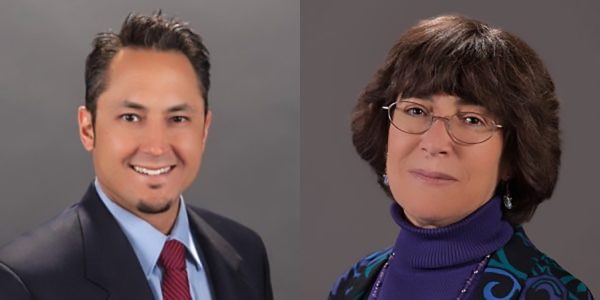
For people with diabetes and other diseases, timely wound healing is important for health.
But for geographic areas with medium to higher levels of naturally occurring arsenic in their groundwater, the contamination may result in slower wound healing for residents––a condition that can lead to infection and suffering.
Two Northern Arizona University researchers, Rob Kellar and Catherine Propper, are working to use their combined expertise to study the issue, create a solution and educate the public to improve outcomes for people with compromised immune systems.
Their project, “Elucidating the Effects of Arsenic and Estrogen on Wound Healing,” is funded by the Southwest Health Equity Research Collaborative (SHERC) at Northern Arizona University (U54MD012388), which is sponsored by the National Institute on Minority Health and Health Disparities. The project began in September in 2017 and is in its final year.
Kellar, the principal investigator, is an associate professor of practice for NAU’s Center for Materials Interfaces in Research and Applications (¡MIRA!). Propper is a professor in the Department of Biological Sciences and the SHERC Research Infrastructure Core co-lead.
“When we challenge skin cells to do a repair process with arsenic, we are seeing them respond negatively,” Kellar said. “That is one of our big findings in the current grant––they appear to be handicapped in the repair process.”
In the project, the investigators demonstrated that arsenic-contaminated water negatively impacts the ability for skin cells to perform their normal functions for wound healing.
“This may translate to clinical scenarios where community members are bathing, consuming arsenic-contaminated water, or this water is being use to water crops or feed livestock or both,” Kellar said. “As part of this project, we have been able to identify specific pathways that may be playing a role in the impact of arsenic on wound healing. We have also been able to explore preliminary treatment modalities to understand future directions to evaluate for the development of therapeutics.”
Kellar has been working in wound healing research for more than 20 years, before he focused his work on how uranium, and now arsenic, contamination in water supplies could block wound healing.
“Our project investigating the role that arsenic-contaminated water has on wound healing is critically important to a number of at-risk populations around the world,” Kellar said. “Locally, right here in Arizona, our Native American population wrestles with this water issue while also struggling with non-healing wounds in many of community members. A better understanding of the interaction between contaminated waters and non-healing skin wounds will enable communities to improve education to their members and develop better prevention and treatment options.”
Propper, who is an endocrinologist and toxicologist, has more than 25 years of experience discovering how environmental contaminants disrupt endocrine pathways and how the interruption affects health.
With Salanga, the three hope to develop a wound healing patch that will accelerate recovery, though Kellar said they are still in the “discovery phase” of research.
“We all bring our unique, comprehensive experiences,” said Propper “Working together we have better outcomes.”
Propper said that their collaboration and groundbreaking research has provided their students an opportunity to gain vital skills and knowledge in their field.
“Notably, our work has supported several students, both graduate and undergraduate, who are winning awards for their research in this field,” Propper said. “Many of these outstanding early-stage investigators are from underrepresented populations.”
Propper said the SHERC grant was an important step in fostering the early stages of their work.
“The SHERC program has allowed us to develop our ideas, and we will continue to move forward with this exciting project through opportunities for outside Federal funding,” Propper said.
Kellar said that the team will be actively pursuing additional future funding for the next steps of their project.
“This will hopefully involve NIH R01 funding,” he said.